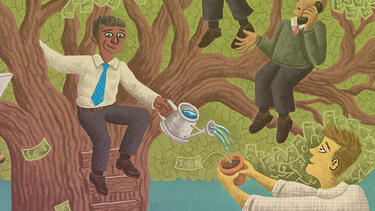Finance
The Corporation Is Centuries Older than We Thought
The genesis of the joint-stock company is usually traced to the founding of the English East India Company and the Dutch East India Company around 1600. New research co-authored by Prof. William Goetzmann says this origin story may be off by centuries.

Aspiring to Be the Next Silicon Valley? Think Twice
A study by Yale SOM researchers suggests that when venture capital funding in a metropolitan area increases, industries with customers outside the region suffer and income inequality widens.

What’s Next for Alibaba?
The giant China-based conglomerate Alibaba raised more than $13 billion in November in a stock offering on the Hong Kong Stock Exchange. We asked Yale SOM’s Heather Tookes and Matthew Spiegel, who have studied the performance of companies after IPOs, what their research suggests about Alibaba’s prospects and its next steps.

In Finance Field, Gender Disparities Are Significant—But Shrinking
More women are being hired for finance positions at top business schools, according to a study co-authored by Yale SOM's Heather Tookes, but progress is slow. The study suggests that this may be due to limited collaborator networks.

What We Talk about When We Talk about Stock Market Crashes
Yale SOM’s Robert Shiller examines how the stock market rise of the 1920s, the crash of 1929, and the Great Depression that followed came to be seen as a tale of recklessness and divine punishment.

For a Path to a Decarbonized Economy, Look to the States
Robert Klee, a lecturer at Yale and the former commissioner of the Connecticut Department of Energy and Environmental Protection, says that state-level approaches to the climate crisis provide a roadmap for a 10-year, trillion-dollar effort to put the U.S. on a path to decarbonization.

Why We Need Finance to Fight Climate Change
There won’t be a transition to clean energy without a way to finance what could be the largest infrastructure project ever undertaken. Yale Insights talked with Jeffrey Schub ’13 of the Coalition for Green Capital about what a National Climate Bank could achieve.

For Top Venture Capital Firms, Success Breeds Success
Most investing success is short lived, but venture capital is an exception, with top VCs beating the average year after year. A new study finds that consistent returns owe as much to a firm’s reputation and early luck as the smarts of its employees.

Companies Invest in Startups to Repair Weaknesses
A study by Yale SOM’s Song Ma shows that companies tend to invest in startups when they are struggling, in order to gain access to innovation and shore up an area of weakness.

Three Questions: Prof. Vineet Kumar on Facebook’s Move into Cryptocurrency
On June 18, Facebook announced Libra, a new cryptocurrency intended to make it easy for individuals and companies to exchange payments anywhere in the world. We asked Prof. Vineet Kumar why a company that started by enabling people to share personal news is now building an alternative financial system.

Don’t Be Surprised by Uber’s Low-Priced IPO—It’s a Sign of Challenges to Come
According to Yale SOM’s Matthew Spiegel and Heather Tookes, an IPO is often followed by disappointing returns, not just for the newly public company but its entire industry.
